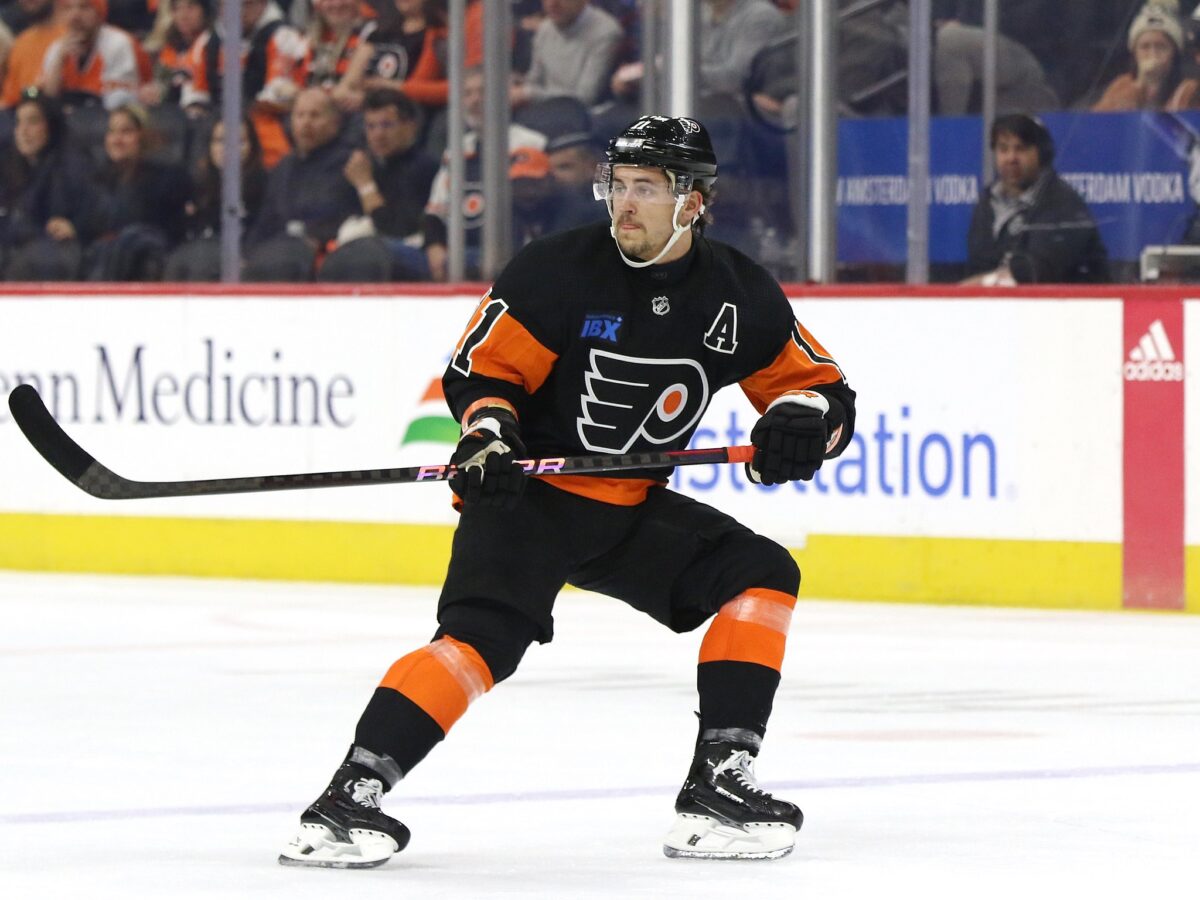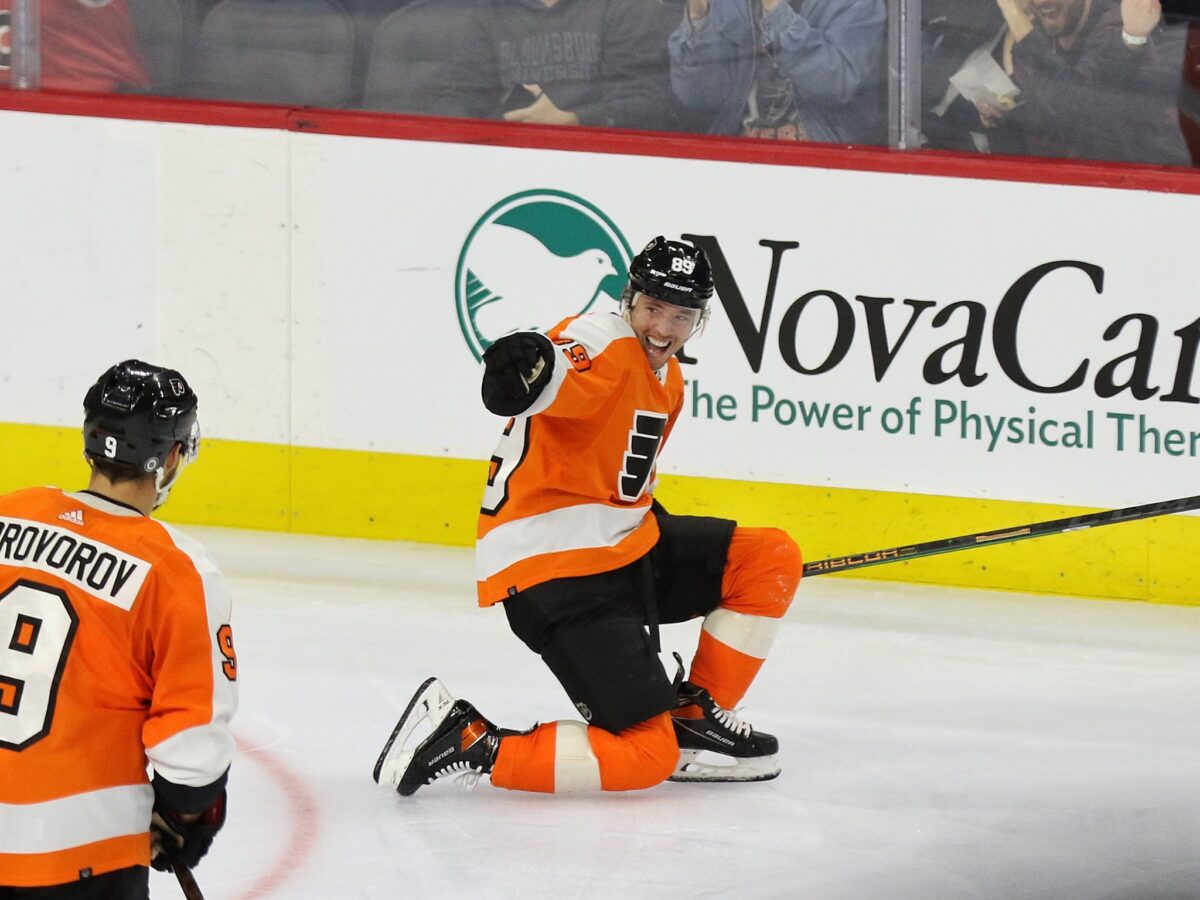On July 25, 2024, the Philadelphia Flyers gave their biggest contract in franchise history to 27-year-old winger Travis Konecny. Set to make $8.75 million on an average annual value (AAV) basis for the next eight years starting in 2025-26, he’ll be pretty old (36) by the time that deal ends. What are some comparable contracts?

As a warning, most of this piece will be somewhat negative. But stick with me, as I promise there’s a positive payoff at the end. We’ll look at two similar contracts from this offseason and two notable Flyers deals, each serving their own purpose as a comparison. Without further ado, let’s take a look.
Sam Reinhart, Florida Panthers
Contract: Eight years, $8.625 million AAV, 9.8 percent of league maximum (expires at age 36)
On July 1, 2024, Sam Reinhart of the Florida Panthers got a nice little payday, even if he should’ve been paid a lot more based on projections. He took a sizable pay cut to achieve yet another Stanley Cup victory, a goal that Konecny talked about when he signed his deal with the Flyers, too.
Reinhart had a whopping 57 goals and 94 points in the regular season, beating Konecny’s 68-point career high in 2023-24 by a wide margin. Putting up 10 more goals in the Panthers’ run to the Stanley Cup, he nearly had as many goals as Konecny had points.
While Reinhart’s 24.5 shooting percentage in 2023-24 was unprecedented and it’ll basically be impossible for him to ever follow that up, he has 243 points in 242 contests with the Panthers in the regular season. In Konecny’s last 242 games, he has just 197 points—that’s 16 fewer points per 82 contests. Here, the offensive battle goes to the Stanley Cup champion.
But that’s just the beginning. Konecny has consistently graded out as one of the worst defensive forwards in the league. Don’t let the fact that he plays on the penalty kill fool you: defense is arguably his biggest weakness. In the 14th percentile of 5-on-5 relative expected goals against per 60 (xGA/60 Rel) among the forwards who have seen 1,000 minutes of ice time since 2021-22, his two-way play is lacking.
The same cannot be said for Reinhart. Not only is he in the 98th percentile for xGA/60 Rel since 2021-22, but he also ended up with Selke Trophy votes in each of his last three seasons including a fourth-place finish in 2023-24. Dominant at both ends of the ice, it’s clear that Florida has a stud on their hands—extending him was their only option.
The fact that Konecny is making more than Reinhart—albeit by $1 million in total value—just doesn’t bode well for him in any comparison. If a 67-goal scorer is the bar, he’s simply never going to win that battle. That shouldn’t be completely held against him, but it’s important to consider.
Pavel Buchnevich, St. Louis Blues
Contract: Six years, $8 million AAV, 9.1 percent of league maximum (expires at age 35)
Let’s pivot to another deal signed in the 2024 offseason. Pavel Buchnevich of the St. Louis Blues received a six-year deal worth $8 million each season. A team with a lot of great prospects that seems to be building on the fly, this makes sense for the Blues. Let’s see how he compares to Konecny.
Last season was Buchnevich’s worst with the Blues, but he still had 63 points in 80 games. His 206 points in 216 contests with St. Louis are better than Konecny’s 182 points in the same span—that’s a difference of 12 points per 82 games. While Buchnevich has played with better offensive linemates, it’s important to recognize the magnitude of the production difference.
If the offensive production wasn’t enough, Buchnevich is also a much better defensive forward than Konecny. His xGA/60 Rel over these past three seasons doesn’t due him proper justice, as he’s only in the 42nd percentile—he’s excellent in his own end even against very tough competition. Allowing 116 goals at 5-on-5 in his last 216 contests versus Konecny’s 147, it’s clear who has the advantage.
So, not only is Konecny making more money than Buchnevich on an AAV basis, but he got two more years, as well. The winner in terms of value has to go to the latter no matter how you look at it.
Owen Tippett, Philadelphia Flyers
Contract: Eight years, $6.2 million AAV, 7.0 percent of league maximum (expires at age 33)
Here, we get into some familiar territory. Owen Tippett was extended by the Flyers in the middle of last season. The 25-year-old got $6.2 million AAV—how does he compare to his current teammate?
In 2023-24, Tippett had 28 goals and 53 points in 78 games. If we adjust his ice time to Konecny’s, however, the numbers look a bit different. On pace for 33 goals and 62 points with the increased workload, the two are more similar than it seems at first glance.
Building upon that point, Tippett played 229 more minutes at 5-on-5 with Cam Atkinson than Konecny did. It might not sound that significant, but Atkinson brought out the worst in his linemates—Tippett was only on the ice for 11 goals with him. Assuming he gets better linemates in 2024-25, boosting his production seems far more likely than not. If that happens, then the latter could rise above his pay grade.
It’s also important to recognize that Konecny arguably played his best hockey when next to Tippett. With a 30-19 goal differential at even strength in the 317 minutes they shared, the results were great. Konecny sacrificed more scoring chances when he was with his 25-year-old teammate, but the Flyers were ultimately at their best when those two were together—they both hold great value.
These points aren’t to bring down Konecny, but rather to bring Tippett up. You could make the argument that the latter is underpaid by a pretty significant amount—he just entered his prime but has the talent to explode in 2024-25 production-wise. But the Flyers probably considered this when they extended him. More reasonably, Konecny is overpaid by a touch.
Cam Atkinson, Columbus Blue Jackets
Contract: Seven years, $5.875 million AAV, 7.4 percent of league maximum (expires at age 36, bought out)
Finally, we have Atkinson. This contract, signed by the Columbus Blue Jackets, is probably the closest comparison we have to Konecny. The main reason for that? Their playing style.

When the two signed their respective deals, they were both proven offensive contributors but below average to disastrous defensively. Atkinson was utilized heavily on the penalty kill, which adds to this comparison. But the key thing to note is how they actually play the game.
In his prime, Atkinson depended on the rush for his offensive production. Since he wasn’t very good defensively, his value came from his ability to dominate in transition and pick up goals that way. He was useful on the power play and in-zone situations when he had solid linemates around him, but his bread and butter came on the rush—this is an identical match to Konecny.
Atkinson’s numbers saw a significant decrease by just the second season of his extension. For his next three campaigns (including the one just mentioned), he was a slightly below-average NHL forward with both Columbus and Philadelphia—then he got hurt with the Flyers entering 2022-23 and wasn’t the same again. With vanishing athleticism, he lost his ability to provide anything on offense in 2023-24.
In his age-34 season, Atkinson was unusable at 5-on-5. He made the Flyers worse as a whole, but head coach John Tortorella didn’t have a ton of options to replace him. His struggles were magnified as a result, leading to his buyout in the 2024 offseason. I’ve seen the claim that Konecny’s deal is justified because the percentage of the cap won’t be as high by the time it’s over, but that didn’t stop Atkinson from being one of the most undesirable contracts in the league.
This whole story goes back to Konecny because of how similar the two players are. They play the same, have similar production, are undersized right-wingers by NHL standards, and both have an injury history. If it looks like a duck, walks like a duck, and quacks like a duck, then it’s probably a duck.
Perhaps Konecny won’t decline as fast as Atkinson did, but it is inevitable that a decrease in production is coming. When his athleticism goes away, he might decline to his former teammate’s level. There’s a misinformed narrative that someone Konecny’s age is just entering his prime. The reality? He’s far closer to exiting it.
Does the Overpayment for Konecny Matter?
That’s too much negativity for my liking, but it’s essential that we recognize the context behind this contract. Not only is it objectively an overpayment on AAV, but also the years. Does that really matter, though? Should we really be concerned about whether or not the Flyers gave him a couple of million dollars too much?
Related: Making Sense of the Flyers’ Travis Konecny Extension
The answer to that question is both yes and no. The very likely outcome of this is that Konecny is either bought out or becomes a shell of himself toward the end of this contract. For those reasons, it’s a bad deal and certainly worrisome. But it’s not the end of the world, either.
Even Atkinson, who is basically a doomsday comparison, wasn’t as good as Konecny was in his prime (which was last season, in my eyes). Assuming that the two age identically, it’s important to recognize that Atkinson was only sub-NHL caliber by the time he was 34—that’s not too shabby.
If that ends up being the case for Konecny, only the last two seasons of his contract would be “bad” per se. For the rest of those campaigns, we can assume he’ll be at a high-end second-line level for a little while and sink to a third-line level toward the end. Is that still overpaid at $8.75 million AAV? Yes, it is. But is that really such a bad thing? Probably not.
Considering the value Konecny provides in the locker room, it is understandable why the Flyers wanted to extend him. The reality is that they’re a solid young team that is waiting on Matvei Michkov’s surge into stardom until they can contend. Keeping Konecny is a low-risk option for the short term that can help the team gradually see some growth. In a few years, they might be in the conversation for the Stanley Cup if all goes well. Trading this kind of player, no matter how bad he might be in the 2030s, is unquestionably a risk.
Keeping Konecny is a positive for most fans, and it’s not hard to see why—extending good players is generally pretty smart. Once we truly comprehend the risk involved, that’s when we can have genuine discussions about the player. It’s an overpayment, but it might all be worth it.
Stats courtesy of Natural Stat Trick